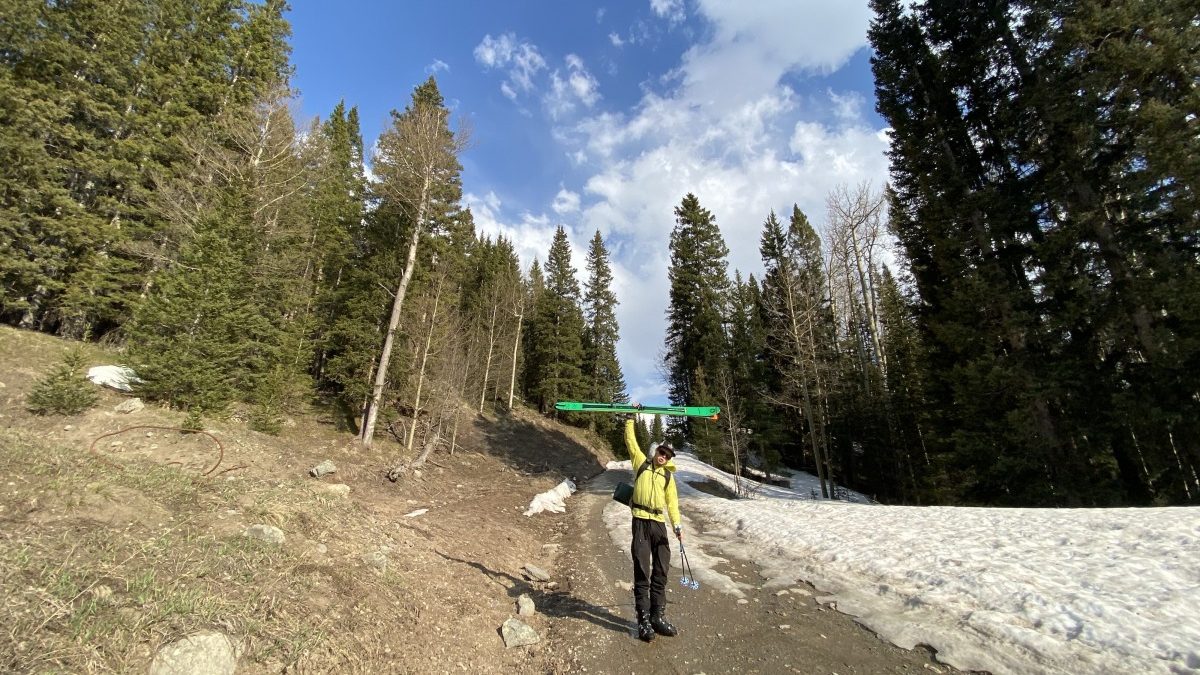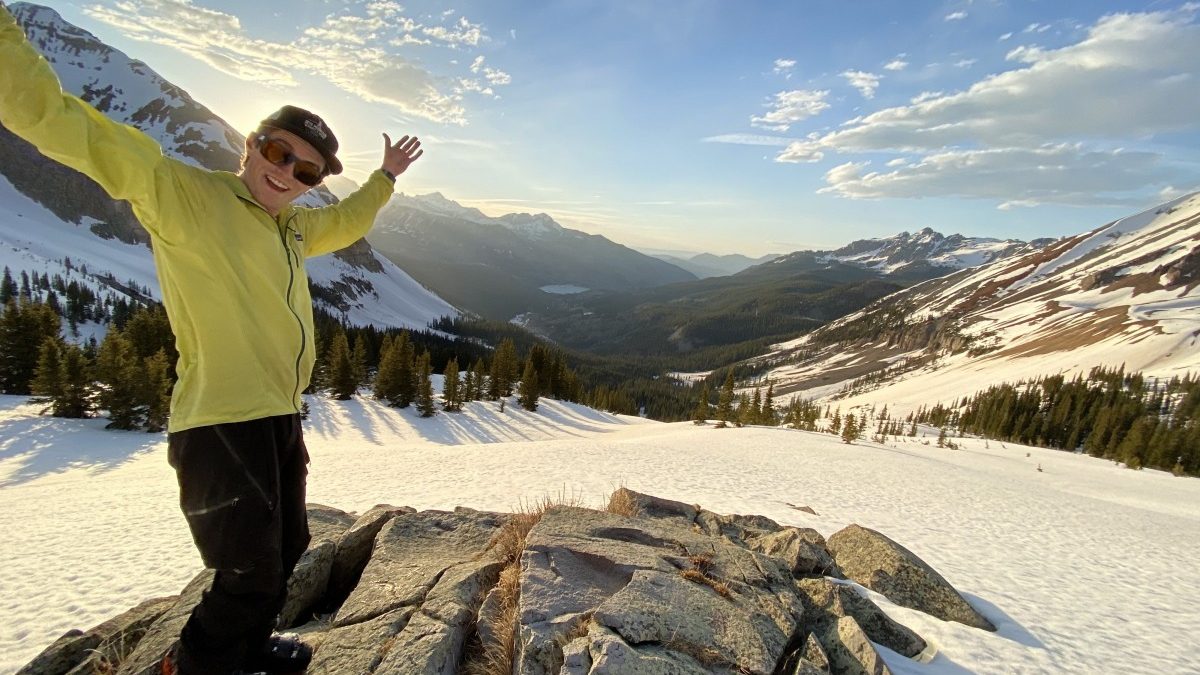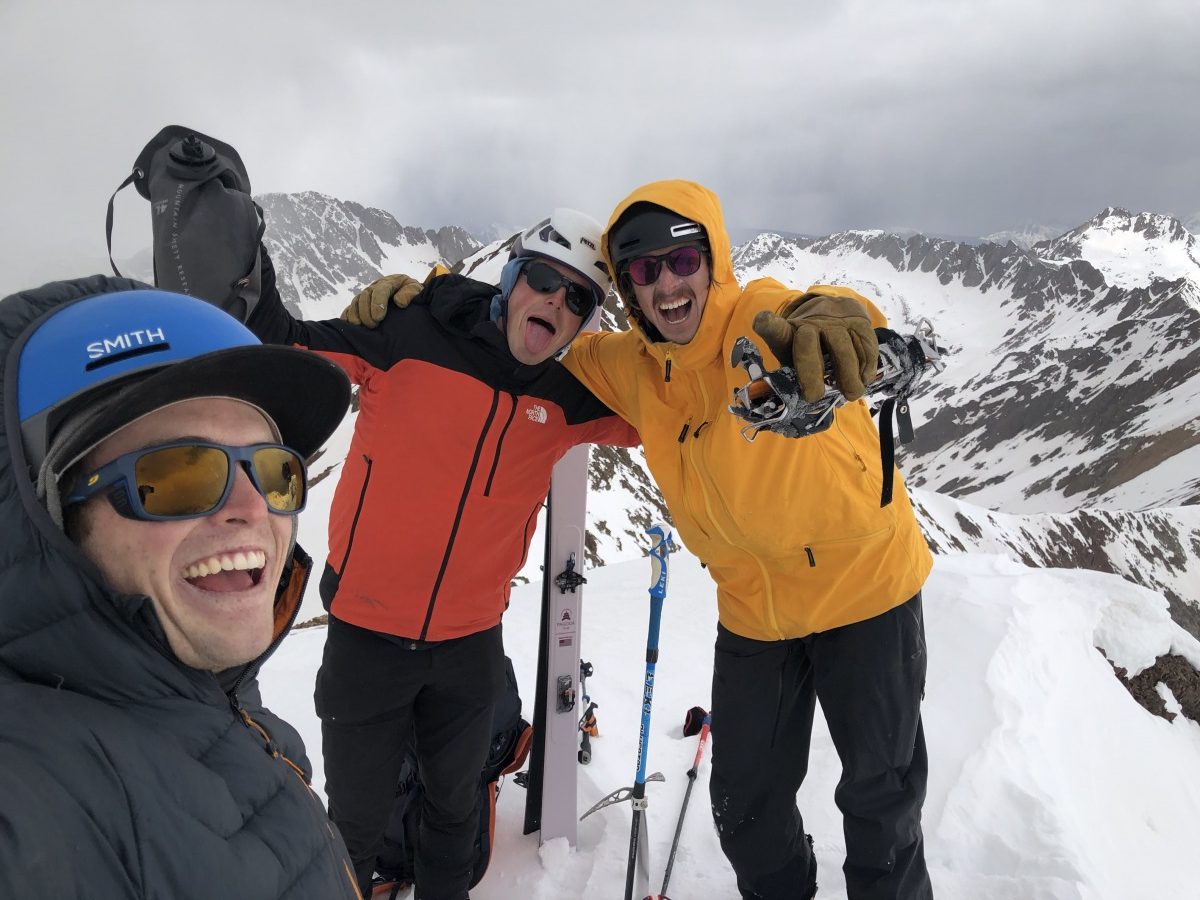Big thanks to onX Backcountry for sponsoring this post. Plan your next ski traverse with 20% off your app subscription. Use the code WILDSNOW20 at checkout.
This is Part II of the Adventure From Home San Juan series. Check out Part I for snowpack, history and trip planning.
Sheamus and I packed up after work and drove the 15 minutes from Telluride to as far as we could up Forest Service Road 627. Our packs were light – carrying dehydrated meals, single wall tents, and few camp comforts.

Here’s Sheamus at the end of the driving and beginning of the skiing. Glorious spring time weather and lightweight overnight packs made our approach casual and fun.
The approach to camp was full of casual conversation commonly saved for the skin track. We debriefed the ski season, shared local small-town gossip (scandalous!), and planned all of our next ‘big mission’ or ‘hidden gem’ outings.

The afternoon approach meant touring at golden hour. You can just make out the Wilson Group on the right skyline.
Soon enough we arrived at camp – right at treeline next to open water from an exposed creek. Camp was quickly built and just in time for us to motor off for a sunset corn ski. The lighting was glorious and the skiing was on the back of the corn cycle bell curve (refreezing). Once back from skiing we began cooking up dinner, drying out ski kit, and making a fire. Could we have skied back to the cars, returned home to a hot dinner, warm bed and internet access? Yes, and in relatively short time. But the value of close-to-home overnighting is to replace those mentioned amenities with other comforts like an open fire, immediate company of close friends, and an early night to bed.

We quickly set up camp, dropped our overnight pack weight, and set off on a golden hour corn harvest. Not much more to ask for than skiing sunset snow with your best bud!

We had a fire our first night out. Duly noted to make sure you set up a fire downwind of your tents to not put ember holes in your fancy single wall tents…
Fritz showed up the next morning as we were brewing coffee and eating granola. There was no rush for our day’s objective. He set up his camp in our now corral of tents and dropped his overnight kit inside. Our plan for the day was to ski the north face of Rolling Mountain. We toured up to a saddle in between us and Rolling Mountain to gain our first glimpse of the peak. The skiing looked steep and thin! The San Juans were at 65% of average snow depth for that time of year and it showed with the leaner-than-usual look of the north face.

Fritz met us during our casual breakfast. We decided to go with three two person tents to get adequate beauty sleep.

A closer view of Rolling Mountain’s north face with Sheamus and Fritz in the foreground. So many inspiring lines! A higher-tide snow year would be needed to fill in the majority of these couloirs.
We transitioned at the col, skied glorious 20° corn to the base of the face, and then transitioned to bootpacking up the north face. We climbed our intended descent to leave a trail of bootpacking crumbs for the way down. We also found value in on-the-go snow assessment of the slope as we climbed.
Cloud fronts rolled in and out of the basin during our ascent. At times our visibility dropped to 10 meters. The cloud cover inhibited the snow from warming at all, making for firmer than expected conditions. The summit soon arrived. Hugs, hoots and hollers were shared as we prepared for our steep descent.
The ski down provided firm ‘backcountry corduroy’ which actually means the spring diurnal cycle never reached a high enough temperature to soften the snow. Some other fun euphemisms to throw around for this are ‘pre-corn’ or ‘engaging snow conditions.’ Nonetheless, the snow was not soft. More isolated cloud fronts blew through on our descent and one of them dumped 2” of graupel. Skiing in graupel was a first for me and made for a memorable meteorological experience.

We bootpacked the entirety of the north face. It was a great opportunity for us to lay a trail of cookie crumbs for the way down and assess the snowpack at the same time.

Three big smiles on the top of Rolling Mountain. I’m showing off the amount of unnecessary water that I brought. A cloud front was rolling in as we transitioned to downhill mode. Is that why they call it Rolling Mountain?

Here’s Sheamus on the upper face. We were happy to have our bootpack in place to help us pick our way down the face.
Once off the north face, we reascended the V8/V9 col to head back to camp. With the sun out and our legs tired, afternoon naps were in order. Post-nap, we skied around camp in a directionless and groggy fashion. Soon the sun dipped below the horizon. We fashioned ourselves another fire and shared an evening laughing too hard, stoking the fire with various techniques and critiques, and savoring what turned out to be a full value day of steep skiing.

Here we are reascending the V8/V9 col. Already pointing out lines for next time. Our descent is traced on Rolling Mountain in red.
The next morning, I could barely sit up. My lower back was so tense that I had to log roll my way out of the tent and groan through getting into a seated position. It was so strange to have such sudden onset back pain. I decided to postpone any decision making to after a few cups of coffee. We talked through our plan for the day over breakfast. I wasn’t able to spend a day out skiing. The weather looked partly cloudy and pleasant. Sheamus and Fritz were still keen to ski. We concluded that I would head back to the car and they would stick around to ski nearby Vermillion Peak (tallest point in San Juan county).
Our plan was to maintain communication with radios during my descent. I would inReach message them once I returned safely to the car. It was slow moving with a heavier pack and a stiffer back, but I eventually arrived at the car where my ski boots were swapped with Crocs and a cold sparkling water was used to pop a few more ibuprofen.
Sheamus and Fritz returned that afternoon to share that Vermillion skied like a frozen coral reef. Their intended line was southern facing, but the partly cloudy morning turned into a fully cloudy and windy midday. The skiing was engaging, they said. Fortunately, both returned safe and smiley back to town where we sipped a few beers and bantered a bit more. Fritz then motored home to Aspen, Sheamus went home to prep for the work week, and I poached a friend’s hot tub to relieve my still stiff back pain. I sat in the tub that evening reveling in my fortune to have quality friends that I get to spend time with in wild places while sliding on snow in total freedom. A bit of back pain is a mild price to pay for such a phenomenal privilege.
Debrief
A group debrief was done on that aforementioned Sunday evening. We came up with the following reflections on our time out:
Things we did well:
— Chose a safe and courteous camp that left the least amount of impact on the environment.
— Kept an open dialogue about snow/terrain/risk assessment while ascending Rolling Mountain. We weren’t attached to the summit and appropriately evaluated terrain as we ascended.
— Put no rush on our outing. There were no speed records to set or big day metrics to meet. Our ski day was safety first, fun second, and ego out of the equation.
Things to improve on for next time:
A consideration we had came from the question: ‘Where was the best skiing?’ The best skiing for us was the eastern facing 20° moraine skiing that we had while approaching Rolling Mountain’s north face. Had we wanted to ski the best snow, we should have lapped that glorious, rolling slope a few times. It was fast, fun carving skiing. The north face of Rolling was steep, technical edging that didn’t elicit the same giggly bliss as that moraine. This was a good dialogue to acknowledge that it’s okay to not ski the biggest, baddest thing around if it doesn’t have the best snow.
Slator Aplin lives in the San Juans. He enjoys time spent in the mountains, pastries paired with coffee, and adventures-gone-wrong. You can often find him outside Telluride’s local bakery — Baked in Telluride.



